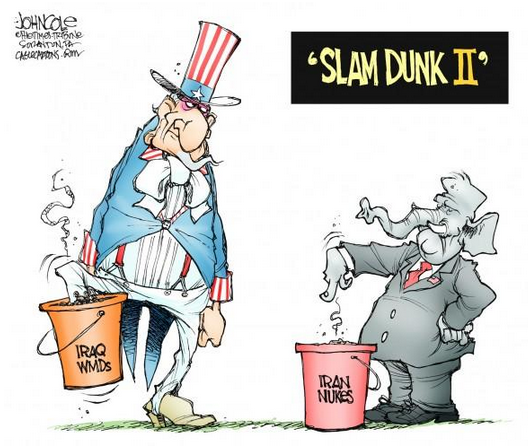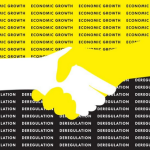 The Islamic Republic of Iran’s consistent effort at developing a long-range nuclear missile remains a concern for the United States. A nuclear Iran can obstruct petroleum shipments, raising oil and energy prices.[ref]C. Hemmer, “Responding to a Nuclear Iran,” in Taking Sides: Clashing Views in World Politics, (New York, NY: McGraw-Hill Companies, 2010), 256.[/ref] Iran can also expand the terrorist threat, by providing nuclear arsenal to “terrorist” organizations, such as Hezbollah and Hamas, and further endanger the U.S. interests and allies in the region. A nuclear Iran may even reassert the nation’s regional hegemony, resulting in a destructive nuclear arms race in a very unstable and violent area. With several entities at stake, the Vendetta therefore, is halting politicians and their calls for military action, and instead support diplomatic attempts to alleviate the situation.
The Islamic Republic of Iran’s consistent effort at developing a long-range nuclear missile remains a concern for the United States. A nuclear Iran can obstruct petroleum shipments, raising oil and energy prices.[ref]C. Hemmer, “Responding to a Nuclear Iran,” in Taking Sides: Clashing Views in World Politics, (New York, NY: McGraw-Hill Companies, 2010), 256.[/ref] Iran can also expand the terrorist threat, by providing nuclear arsenal to “terrorist” organizations, such as Hezbollah and Hamas, and further endanger the U.S. interests and allies in the region. A nuclear Iran may even reassert the nation’s regional hegemony, resulting in a destructive nuclear arms race in a very unstable and violent area. With several entities at stake, the Vendetta therefore, is halting politicians and their calls for military action, and instead support diplomatic attempts to alleviate the situation.
Despite signing the Non-Proliferation Treaty, a D.C. press conference in 2002 revealed a uranium enrichment facility in Central Iran.[ref]M. Kibaroglu, “Good for the Shah, Banned for the Mullahs: The West and Iran’s Quest for Nuclear Power,” Middle East Institute 60 no. 2 (2006): 209, retrieved April12, 2010, http://www.jstor.org/stable/4330247.[/ref] Immediately, the U.S. requested Iran to send its “nuclear dossiera to the United Nations Security Council.” Yet President Mahmoud Ahmadinejad only acknowledged his failure to report to the International Atomic and Energy Agency (IAEA), and defended Iran’s “inalienable right of the member states to develop nuclear energy for peaceful purposes.”[ref]Ibid, 210.[/ref] In 2009, the IAEA announced a second uranium enrichment plant in Qom, which Ahmadinejad claimed fell within the “parameters of the U.N. nuclear watchdog’s rules.”[ref]Al Jazeera English, “Timeline: Iran’s Nuclear Programme,” Al Jazeera English, April 9, 2010, retrieved on 12 April 2010, http://english.aljazeera.net/news/middleeast/2007/12/20085251853218888.html[/ref] Throughout these discoveries, the U.S., the European Union, and the U.N. enforced a series of sanctions against the Iranian government, while attempting to negotiate a deal with Ahmadinejad. In 2013, the Iranians elected Hassan Rouhani as president, who asserted that the country will maintain its nuclear program, while being more transparent. With a change in leadership, the U.S. and Iran are now working on a comprehensive solution to this nuclear weapons issue.
Some analysts have proposed using military action to stop Iran from developing nuclear weapons, and halting a crisis. But containing a nuclear Iran comes with a heavy political and military price. The U.S. would need to deploy naval and ground units across the region. In addition, the U.S. would have to secure intelligence bases in order to monitor any attempts by Iran to transfer nuclear technology. Most importantly, to defend its credibility, the U.S. would have to defend its allies in the region with military force should Iran launch an attack. But those against a military strike argue that such policy would only damage the infrastructure of nuclear facilities, not the Iranian ambition. Still determined, the Iranians could rebuild their nuclear facilities, which would then warrant another attack by the U.S., leading to another open-ended war.[ref]R. Rosenkranz, “Intelligence Squared U.S. Series” [radio transcript], The Rosenkranz Foundation, 2009, retrieved from http://intelligencesquaredus.org/wp-content/uploads/Diplomacy-with-Iran-051209.pdf[/ref] Moreover, a military strike may only destroy the nuclear facilities known to U.S. intelligence, not all of them. Finally, a military strike against Iran, the world’s second largest energy reserves, can raise the price of oil and energy.[ref]Hemmer, “Responding to a Nuclear Iran,” in Taking Sides: Clashing Views in World Politics, 255.[/ref] Therefore, any preventive attack is only a temporary fix.
On the other side, several other analysts encourage the U.S. to continue pursuing a policy of diplomacy. Already, diplomatic attempts have resulted in what politicians are calling a “milestone,” and “Obama’s first major foreign policy achievement.”[ref]Barbara Slavin, “How Iran and world powers finally got to yes on a nuclear deal,” Al Jazeera English, November 23, 2014 retrieved on August 30, 2014, http://america.aljazeera.com/articles/2013/11/23/what-the-iran-nucleardealmeans.html[/ref] For six months, Iran has agreed to not build or repair any centrifuges. In return, the U.S. will ease its sanctions, leading to about seven billion dollars in relief. This preliminary agreement places developments on hold while the U.S. and Iran work on a comprehensive deal. Despite such achievement, Senator Lindsey Graham claims that “unless the agreement requires dismantling of the Iranian centrifuges, we really haven’t gained anything.”[ref]Ibid.[/ref] Liz Cheney, an American attorney, argues for more coercive methods regarding effective diplomacy with Iran. The Obama Administration, for instance, should include a credible threat of military force if diplomacy fails.[ref]Rosenkranz, “Intelligence Squared U.S. Series” [radio transcript], 5.[/ref]
Nevertheless, diplomacy remains to be the more realistic choice in dealing with a potential nuclear Iran. After the Bush Administration’s unilateral and “willful disregard of International treaties,” U.S. authority had been greatly undermined.[ref]Fred Kaplan, Daydream Believers: How a Few Grand Ideas Wrecked American Power, (Hoboken, NJ: John Wiley & Sons, 2008), 197.[/ref] To regain their initial status, the U.S. “must prove they’re worth following,” and practice peaceful methods. Pursuing diplomacy is also cost effective – as of March 2014, $1.57 trillion dollars have allocated to fund the wars in Iraq and Afghanistan.[ref]“Counter Notes and Sources,” Fighting for a U.S. federal budget that works for all Americans, last modified March 10, 2014, accessed August 31, 2014, https://www.nationalpriorities.org/cost-of/notes-sources/.[/ref] If the U.S. attempted diplomacy, then funds can be used to alleviate more domestic issues instead – like unemployment, student loans, etc. Moreover, if the U.S. succeeded in negotiations, consumers can see a dip in oil prices, with “possibly to $20 to $30 per barrel.”[ref]Justine Hofherr, “How a Nuclear Deal With Iran Could Affect Gas Prices,” Boston.com, March 20, 2015, retrived on May 3, 2015, http://www.boston.com/cars/news-and-reviews/2015/03/20/how-nuclear-deal-with-iran-could-affect-gas-prices/zNPJW06GP9cKajAciotM1K/story.html[/ref]
Take Action:
To support the diplomatic process between the U.S. and Iran, visit “Win without War” where you can not only learn more about U.S.-Iranian negotiations, but also use one of the letter templates in order to state your opinion to your congressperson.



